A (Very) Brief Pictorial History of Beholders
The creation of Terry Kuntz, brother of Rob Kuntz, the beholder first appeared in Supplement I to OD&D, Greyhawk in 1975. Since then, the eye tyrant (as it is sometimes known) has become a very strong contender for title of Most Iconic Monster of Dungeons & Dragons. It's also one of my favorite monsters in the game. The first illustration of a beholder appeared on the cover to Greyhawk and was drawn by Greg Bell. As you'll see from the artwork that follows, Bell's version of the beholder is quite distinctive, having a smooth body, a sleepy-looking central eye, and a comparatively small mouth.
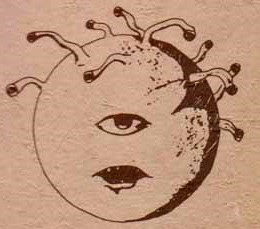 Tom Wham, in the AD&D Monster Manual (1977), takes a slightly different tack. His beholder looks to be armor plated. Its central eye is large and bulbous, while its mouth is huge. This is the first version of the monster I ever saw, so it's my default image of it.
Tom Wham, in the AD&D Monster Manual (1977), takes a slightly different tack. His beholder looks to be armor plated. Its central eye is large and bulbous, while its mouth is huge. This is the first version of the monster I ever saw, so it's my default image of it.
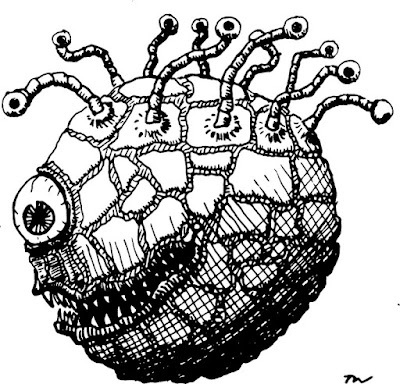 A couple of years later, in 1979, The Official Advanced Dungeons & Dragons Coloring Album was published by Troubadour Press. The book contained this image of the beholder by Greg Irons. In general, I'd say it looks closer to Wham's illustration than Bell's.
A couple of years later, in 1979, The Official Advanced Dungeons & Dragons Coloring Album was published by Troubadour Press. The book contained this image of the beholder by Greg Irons. In general, I'd say it looks closer to Wham's illustration than Bell's.  The next year, 1980, was when the first official AD&D miniatures appeared. Here's a beholder as painted by Ray Rubin, from the box art of the "Dwellers Below" set. Its appearance is quite close to that of Wham's illustration.
The next year, 1980, was when the first official AD&D miniatures appeared. Here's a beholder as painted by Ray Rubin, from the box art of the "Dwellers Below" set. Its appearance is quite close to that of Wham's illustration.
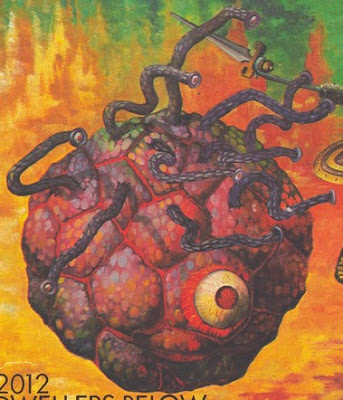 The actual beholder miniature from the set looks like this:
The actual beholder miniature from the set looks like this:
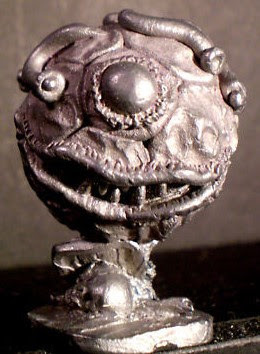 Issue #76 of Dragon (August 1983) includes the article, "The Ecology of the Beholder" by Ed Greenwood and Roger E. Moore. Accompanying it is this illustration of a beholder by Roger Raupp. Take note of its eye stalks, which looks a bit like the legs of a crab or spider.
Issue #76 of Dragon (August 1983) includes the article, "The Ecology of the Beholder" by Ed Greenwood and Roger E. Moore. Accompanying it is this illustration of a beholder by Roger Raupp. Take note of its eye stalks, which looks a bit like the legs of a crab or spider.
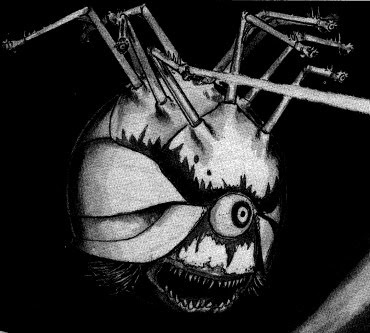 A month later, in September 1983, the second episode of the Dungeons & Dragons cartoon series featured a beholder. Its eye stalks are snaky or wormy in appearance, while its mouth has the largest teeth of any version yet.
A month later, in September 1983, the second episode of the Dungeons & Dragons cartoon series featured a beholder. Its eye stalks are snaky or wormy in appearance, while its mouth has the largest teeth of any version yet.
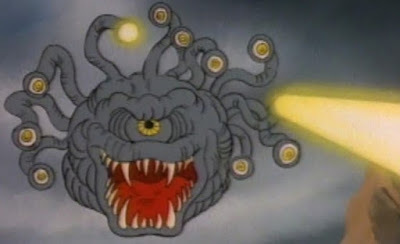 Citadel acquired the AD&D miniatures license in 1985 and produced a beholder figure. I don't know the precise year in which it was released. Though it's somewhat hard to tell from this image, the miniature looks pretty close to the Monster Manual depiction, right down to the plated body.
Citadel acquired the AD&D miniatures license in 1985 and produced a beholder figure. I don't know the precise year in which it was released. Though it's somewhat hard to tell from this image, the miniature looks pretty close to the Monster Manual depiction, right down to the plated body.
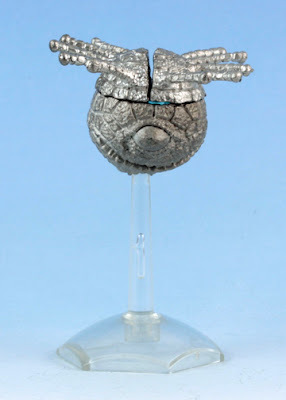 Also released in 1985 were the Dungeons & Dragons Master Rules, which included this picture of a beholder, as imagined by Jeff Easley. This illustration is interesting for its half-lidded appearance, something that's not really present in previous versions.
Also released in 1985 were the Dungeons & Dragons Master Rules, which included this picture of a beholder, as imagined by Jeff Easley. This illustration is interesting for its half-lidded appearance, something that's not really present in previous versions.
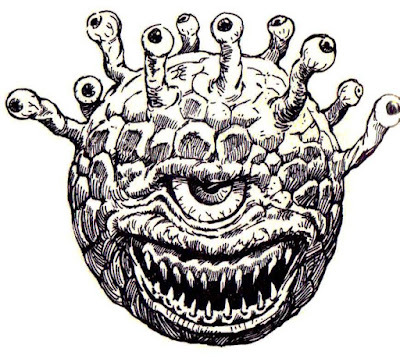
Toward the end of the 1e period, TSR released Waterdeep and the North (1987) for use with the Forgotten Realms setting. Its cover includes a beholder by Keith Parkinson. His version not only includes segmented eyestalks like Roger Raupp's but also upper and lower eye lids.
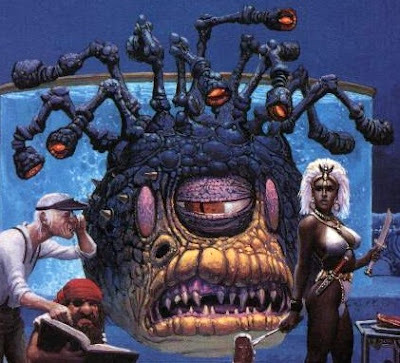 The cover to the Monstrous Compendium (1989) features a beholder by Jeff Easley. The armor plates are not present. Instead, the beholder appears to be very fleshy in appearance.
The cover to the Monstrous Compendium (1989) features a beholder by Jeff Easley. The armor plates are not present. Instead, the beholder appears to be very fleshy in appearance.
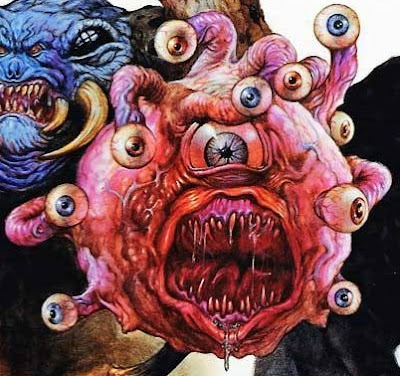 Meanwhile, the MC's interior gives us this illustration by Jim Holloway. The armor plates are back, as are the broad proportions of Wham's Monster Manual illustration (though the eye stalks look unique).
Meanwhile, the MC's interior gives us this illustration by Jim Holloway. The armor plates are back, as are the broad proportions of Wham's Monster Manual illustration (though the eye stalks look unique).
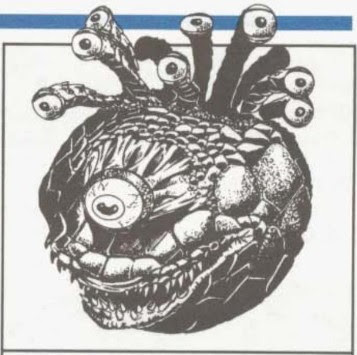 The Monstrous Manual (1993) gives us this very odd illustration by Tony DiTerlizzi, which may have the largest central eye-to-body proportions of any version of the beholder.
The Monstrous Manual (1993) gives us this very odd illustration by Tony DiTerlizzi, which may have the largest central eye-to-body proportions of any version of the beholder.
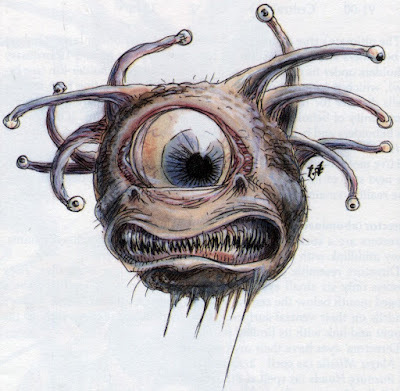 I have intentionally excluded all the artwork of beholders found in the Spelljammer boxed sets and modules, both because there's so much of it and because it's intentionally varied in keeping with its idiosyncratic interpretation of beholders. Consequently, I'm not certain the extent to which they're at all representative of depictions of these monsters during the TSR era of D&D. On the other hand, it's quite possible these depictions were influential on those that followed in the '90s and into the 21st century. If anyone has any thoughts on this particular point, I'd be interested in hearing them.
I have intentionally excluded all the artwork of beholders found in the Spelljammer boxed sets and modules, both because there's so much of it and because it's intentionally varied in keeping with its idiosyncratic interpretation of beholders. Consequently, I'm not certain the extent to which they're at all representative of depictions of these monsters during the TSR era of D&D. On the other hand, it's quite possible these depictions were influential on those that followed in the '90s and into the 21st century. If anyone has any thoughts on this particular point, I'd be interested in hearing them.As usual, I've no doubt left out a lot of illustrations, focusing primarily on those I either remembered clearly from my youth or those appearing in products to which I have ready access. If you feel like there are notable ones I've forgotten, I'd be interested in learning about those, too.
Published on July 28, 2024 21:00
No comments have been added yet.
James Maliszewski's Blog
- James Maliszewski's profile
- 3 followers
James Maliszewski isn't a Goodreads Author
(yet),
but they
do have a blog,
so here are some recent posts imported from
their feed.



